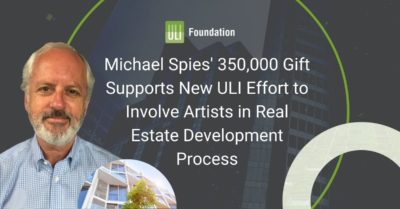
MAY 12, 2022
With the help of a $350,000 gift from former global governing trustee Michael Spies, the Urban Land Institute is launching a program through which artists will be introduced into the early stages of project developments that are seeking innovative connections to their communities. It is envisioned as an important component of creative placemaking activities that have long been highlighted among best practices by ULI.
The new Art in Place program will help developers or community sponsors form creative partnerships with creators in a variety of fields, from painting and sculpture to dance, theater, and music, and even culinary arts.
Art in Place will approach placemaking from a fresh, new angle, says Juanita Hardy, a consultant to ULI and former ULI senior visiting fellow for creative placemaking, who helped lead the program’s formation.
“It’s engaging artists—as members of the project team with architects, designers, and others—recognizing the context and place in which a project is situated, and creating new developments that address the diverse needs of all project stakeholders, including the community, developer and its partners, and government.”
Michael Spies—a former senior managing director of Tishman Speyer and now active in real estate technology ventures through his firm Fuse Strategies and as a venture partner with Los Angeles–based Navitas Capital—made the generous donation to get the idea off the ground and create the Art in Place concept and fund.
The program is “activating Michael’s vision, which is an innovation and a breakthrough, for getting artists involved early to shape a project in new, different, exciting, and purposeful ways,” Hardy explains.
“I’ve had the pleasure of engaging with artists in different ways while developing projects over the years, and I’ve often been excited by their fresh perspectives,” Spies says. “These can serve as catalysts in creating successful spaces within developments and enhancing communities in truly sustained ways. In recent years, as the lines between different uses of real estate have blurred, and ‘content’ has increasingly become part of the activation of real estate, the role that may be played by the artist in the conception of land use and development has grown ever more promising.”
Spies, whose family includes multiple generations of musicians, has long had an interest in forging a connection between real estate and the arts. In 2018 he was jury chairman for the ULI Prize for Visionaries in Urban Development, which was awarded that year to Chicago sculptor, arts educator, and urban planner Theaster Gates. In his presentation of the award, Spies lauded Gates’s adaptation and repurposing of ordinary materials in his art and his recognition of “the important role his art could play in building a strong community.”
Spies explained the genesis of Art in Place.
“Around 10 years ago at a ULI event in Europe, we had a presentation from a Dutch artist, Jeanne van Heeswijk, who spoke about work she had done in Liverpool to rebuild a community that had suffered a decline,” he says. “In speaking about the ideas and projects that came about, she spoke about the power of networks and how she exists within a network of artists who in turn dynamically connect with other networks of all types.
“A couple of years later, I had the pleasure of spending half a day with Theaster Gates on the South Side of Chicago, in part to talk about an art installation he would be doing in Frankfurt, Germany. My visit coincided with his hosting a national network of artists who were meeting within his studio. The seed of Art in Place grows from the idea that ULI, which is the ultimate network of land use professionals globally, can catalyze inspired development by tying to networks of artists who exist within the same communities where ULI members are engaged.”
Art in Place will leverage ULI’s existing body of work in placemaking, which dates to 2016, when the Institute launched the Creative Placemaking Project as part of its Building Healthy Places Initiative, now part of the ULI Randall Lewis Center for Sustainability in Real Estate.
While some of the program’s structure is still taking shape, the fund will engage local district and national councils to assist in forming effective partnerships with artists. In addition, ULI’s technical assistance panels, which work with local areas to find solutions for land use challenges and foster beneficial development, may play a role in connecting developers in various cities with artists. The program will also leverage ULI’s globally executed Advisory Services panels, which in recent years have seen an uptick in the need for expertise in creative placemaking. The program will gather and distill insights learned from developer/artist collaborations and make that information available to a broader audience of ULI members.
Art in Place is aligned with ULI’s diversity, equity, and inclusion priorities by its very nature, involving early artist engagement and community-focused design.
“My hope is that others who see the same obvious potential through drawing artistic expressions into successful development strategies will join in this effort, enabling the breadth and impact of this program to grow over time,” Spies says. “We should see many exciting new examples of creative placemaking through bringing Art in Place to projects and their communities across the ULI map.”

